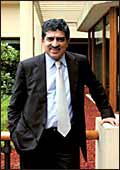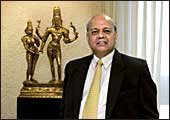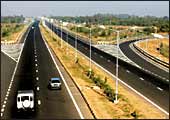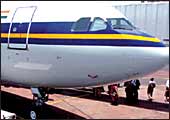|
It
turns 14 this year, yet the BT 500 has only just arrived. The
listing, the first of its kind in the country, is many things.
It is a measure of performance. It is a point-in-time assessment
of a company's past, present and future (the last as measured
by the expectations of investors). And it is an indicator of what's
in, and what's out, in terms of businesses, even individual companies.
The past listings, 13 of them, tried to be all that, but they
were constrained by the pace of evolution of India Inc., and that
of the country's stock markets. In the first half of the 1990s,
the listing was biased heavily in favour of past performance.
In the second, and in the first years of the 21st century, it
showed itself susceptible to speculative forces (HFCL anyone?).
Circa November 2005, the stock market (despite talk of an impending
correction) is at a high; even a fall of 10 per cent from its
current position will see the Bombay Stock Exchange's Sensex at
around 7,500 (a number that everyone, including the bulls, will
take happily); and companies are justifying their seemingly-high
valuations with revenues and profits of a magnitude they haven't
seen before and peg (price-earnings to growth) ratios less than
or equal to 1. In an ideal market, the ratio of a company's price-earnings
multiple and its earnings growth should be 1.
| THE TOP 10 |
Company
Average Market capitalisation, H1 2005-06
|
1
RELIANCE INDUSTRIES
Rs 88,281.73 crore
2 TATA
CONSULTANCY SERVICES
Rs 62,462.96 crore
3 INFOSYS
TECHNOLOGIES
Rs 60,584.70 crore
4 WIPRO
Rs 49,677.94 crore
5 BHARTI
TELE-VENTURES
Rs 48,647.50 crore
6 ITC
Rs 39,716.41 crore
7 HINDUSTAN
LEVER
Rs 33,688.57 crore
8 ICICI
BANK
Rs 33,166.46 crore
9 HDFC
Rs 21,144.45 crore
10 TATA
STEEL
Rs 20,637.88 crore
|
Any stock with a peg ratio of 1 is fairly
valued; those with peg ratios less than 1 are undervalued. Bharti
Tele-Ventures' peg ratio, for instance, is just around 0.3. And
Glenmark Pharmaceuticals' less than 0.2. While the latest bull
run has left even penny stocks looking respectable (even after
the recent bloodbath in that category), the fundamental soundness
of the valuations of companies in the higher reaches of the BT
500 (as evident in their low peg ratios) is indisputable. That
is one reason why the BT 500 has arrived.
The other reason has to do with the listing
itself. With the markets beginning to reflect a company's real
worth, more and more organisations are beginning to tap it. This
year's BT 500 is, thus, a far more accurate reflection of the
diversity of India Inc than last year's. And next year's listing
could be even more so.
In the top 50, for instance, are companies
from sectors as diverse as software, fast moving consumer goods,
banks and financial services, automotive (carmakers, two-wheeler
manufacturers, even auto component firms), metals (steel as well
as non-ferrous), pharmaceuticals, petrochemicals, energy, cement,
infrastructure entertainment, even airlines.
The top 100 includes companies from all these
sectors and then some. The first companies from a sector that
decide to tap the stock markets will start with high valuations,
the result of what analysts call 'scarcity premium', but over
time, as more companies from the business make initial public
offerings (IPOs), these (the valuations) will become realistic.
Three years from now, the top 10 of the BT 500 could well have
a retail chain, a biotech hotshop, an airline, and a media firm
apart from usual suspects from sectors such as software, steel,
and energy.
Behind The Numbers
THE TOP 10 GAINERS
By absolute market capitalisation. |
| RANK |
COMPANY |
INCREASE |
| 3 |
INFOSYS TECHNOLOGIES |
22,461.89
|
| 1 |
RELIANCE INDUSTRIES |
21,245.43
|
| 5 |
BHARTI TELE-VENTURES |
20,889.38
|
| 6 |
ITC |
14,771.63
|
| 2 |
TATA CONSULTANCY SERVICES |
14,332.62
|
| 8 |
ICICI BANK |
13,341.19
|
| 4 |
WIPRO |
12,421.31
|
| 12 |
HDFC BANK |
8,260.07
|
| 10 |
TATA STEEL |
7,470.51
|
| 9 |
HDFC |
6,674.57
|
| Figures are
absolute increase in market capitalisation in Rs crore. Companies
that listed on the stock exchanges in the past 12 months have
not been considered. Only companies with a market capitalisation
over Rs 1,000 crore have been considered |
The BT 500 isn't the only corporate listing
around; there are several others. One includes information about
closely held and unlisted companies, but the data is at least
a year, some times two, old, immediately rendering it irrelevant.
Others rank companies on sales alone, but this magazine has always
believed that only a market capitalisation based listing can look
at the future.
Still others opt for hybrid listings, marrying
unrelated measures such as sales and assets. For the record, the
BT 500 listing also ranks companies on the basis of sales and
net profit, and while it does provide information on the total
assets of a company, it does not believe in an asset-based ranking
(simply because the utilisation of assets is far more important
than the assets themselves).
A market value-based listing is prone to
stock market aberrations, but these are temporary phenomenon.
If averages won't weed out the kinks (the ranking is based on
average market capitalisation in the period between April 1, 2005
and September 30, 2005), then a comparison with the previous year's
listing will.
That integrity, and its inherent dynamism
make the BT 500 a perfect trend-spotter.
 |
 |
 |
It is like the old finance boom,
and it isn't.
Anil Ambani's Reliance
Capital, for
instance, has emerged the
vehicle for his investments |
As this
magazine goes
to press
(November 11), Nandan
Nilekani's
Infosys has overtaken
TCS to
emerge #2 |
Just when everyone was begining to take Videocon for granted,
Chairman Venugopal Dhoot struck aggressive deals with Thomson
and Electrolux and unveiled a grandiose merger plan |
Big Is Beautiful
Nine of the 10 companies that registered
the highest increase in market capitalisation (between last year's
listing and this year's) figure in the top 10. The only one that
doesn't, HDFC Bank, comes in at #12. That shouldn't surprise anyone:
these companies have posted revenue and net profit growth rates
that are staggering or just short of it; four of these companies
are in the top 10 in terms of sales, and the lowest rank (by sales)
that any of these companies boasts is 35 (again, HDFC Bank).
At one level, this loops back to reinforce
a growing belief, among analysts, fund managers, and just about
anyone who has anything to do with the market that Sensex levels
of 7,500-plus are reasonable. At another, it proves that there
is something called economies of scale.
The three software companies in the listing,
for instance, have broken away from the rest of the pack. Not
only are they growing revenues and earnings faster than other
companies in the business, their size is allowing them the luxury
of trying new things.
THE MARKET'S FAVOURITES
Companies enjoying the highest market
capitalisation to sales multiple. |
| RANK |
COMPANY
|
MARKET CAP-SALES
MULTIPLE
|
| 110 |
VIDEOCON INDUSTRIES |
119.77
|
| 71 |
FINANCIAL TECHNOLOGIES (INDIA) |
89.25
|
| 82 |
INDIA BULLS FINANCIAL SERVICES |
47.56
|
| 105 |
YES BANK |
37.54
|
| 45 |
RELIANCE CAPITAL |
30.1
|
| 164 |
GATEWAY DISTRIPAKS |
13.18
|
| 117 |
KSL & INDUSTRIES |
10.3
|
| 3 |
INFOSYS TECHNOLOGIES |
8.49
|
| 23 |
SUN PHARMACEUTICAL |
8.31
|
| 102 |
HFCL INFOTEL |
7.19
|
Wipro, for instance, believes in the acquisition
approach. Infosys has invested in a consulting subsidiary. It
isn't just software; ICICI Bank and HDFC Bank have used scale
to good effect, setting the retail banking industry on fire. As
has Bharti Tele-Ventures, which has parlayed an all-India presence
and around 15 million subscribers (as on October 31) into real
money. And when the buzz on D-street hinted that Reliance would
acquire a $15-billion (Rs 67,500-crore) us- firm, not many people
were surprised by the magnitude of the amount involved or that
RIL was considering something as audacious as this (never mind
that the rumour proved baseless).
The New New Thing
A few years ago, this was media and entertainment.
Then it was pharmaceuticals. Then retail. The most significant
thing about this year's BT 500 is that there is no one new new
thing.
On the basis of valuations, it is evident
that analysts and investors are betting on several companies in
a variety of sectors. They are hoping new banks on the block Kotak
Mahindra and Yes will replicate, at least to some extent, the
success of those who came before them, ICICI Bank and HDFC Bank.
THE TOP 10 GAINERS
By absolute market capitalisation. |
| RANK |
COMPANY |
INCREASE
|
| 178 |
SPICEJET |
1,284.65
|
| 110 |
VIDEOCON INDUSTRIES |
1,189.69
|
| 71 |
FINANCIAL TECHNOLOGIES (INDIA) |
998.49
|
| 82 |
INDIABULLS FINANCIAL SERVICES |
888.40
|
| 117 |
KSL & INDUSTRIES |
779.59
|
| 142 |
GUJARAT FLUOROCHEMICALS |
730.13
|
| 51 |
ESSAR OIL |
672.06
|
| 135 |
NAGARJUNA CONSTRUCTION CO. |
602.92
|
| 185 |
UNITED BREWERIES |
518.24
|
| 173 |
GUJARAT NRE COKE |
478.72
|
| Figures are
per cent increase in market capitalisation. Companies that
listed on the stock exchanges in the past 12 months have not
been considered. Only companies with a market capitalisation
over Rs 1,000 crore have been considered |
They are betting that Jet Airways can scale
up and become one of the largest airlines in this part of the
world (and by virtue of being the only other airline company listed,
SpiceJet comes in at #178 in the listing). They have seen Pantaloon's
Kishore Biyani deliver, and expect him to deliver some more (Pantaloon
enters the top 100 at #69 for the first time). And they are cautiously
optimistic about the software company everyone is talking about,
Sasken, which debuts in the listing at #172. Heightened investor
interest in past new new things (such as software and pharmaceuticals)
have boded well for these businesses. There are some 43 software
companies in this year's listing and at least a handful of them
are there simply because investors believe Indian it firms have
what it takes too succeed.
The Ideal Top Ten
| On the basis of valuations, it is evident
that analysts and investors are betting on several companies
across sectors |
What would be an ideal (from the perspective
of contributing to a GDP growth of around 8 per cent to 10 per
cent a year) top 10, or top 20 in the BT 500? That's fairly straightforward.
There would have to be a retail firm (maybe two) because as the
US experience shows, retail is the lifeblood of the economy. One
carmaker would have to feature in the top 10 (the automotive industry
is a mixture of the best and the worst of old-world manufacturing).
As would, for obvious reasons, one bank. A couple of energy firms
(at the very top of the listing) is a must; there is a direct
correlation between energy consumption and economic growth. A
few software and pharmaceutical firms wouldn't hurt either. Nor
would an infrastructure firm, one into engineering or construction.
It would be nice to have a media firm too (then, we could be getting
greedy).
Will 2010 see a listing such as this?
Banking: This Boom Won't Crash, Not
Yet
Retail is it, but banks are betting
on SMEs and non-metros for growth. |
 |
 |
 |
| Retail Ahoy: (Top to bottom) ICICI
Bank's Chanda Kochhar, Yes Bank's Rana Kapoor and SBI's
A.K. Purwar are all betting on the retail banking boom |
The retail lending boom shows
few signs of letting up, with Indian banks flooding the market
with cheap consumer finance. And even as the doomsayers crawl
out of the woodwork, questioning the sustainability of the
retail surge, bankers are taking various steps to ensure that
the boom doesn't turn into a bubble. Some are spreading their
risks by moving away from the big cities into smaller towns.
Others are aggressively tying up with user companies (auto
makers, for instance). At the same time, lending to small
and medium enterprises (SMEs) is picking up, which gives banks
another growth avenue to train their sights on. "The
penetration of banking into rural and semi-rural areas is
still very low, which offers plenty of scope for growth,"
says N. Mohan Raj, Chief Executive Officer, LIC Mutual Fund.
Yet, it's clearly the homes, cars, credit cards and holidays
you purchase that's keeping the banks' cash registers ringing,
be it the oldest state-owned State Bank of India, the market
savvy ICICI Bank and HDFC Bank, or the new kids on the block,
Kotak Bank and Yes Bank. For instance, ICICI Bank, which
is sitting on the largest retail portfolio of all, witnessed
a 68 per cent jump in its retail assets to Rs 56,133 crore
in March 2005. "The transformation of the erstwhile
ICICI Ltd from a financial institution to a retail powerhouse
has been phenomenal," says Asit Koticha, Managing Director,
ASK Raymond James.
Goliath SBI, with a balance sheet size of Rs 4,70,000
crore, has also successfully transformed itself from a typical
state-owned bank to a powerhouse of financial services,
especially housing, automobile and personal loans. According
to SBI, its retail advances in the personal segment have
grown by Rs 13,301 crore, with the outstanding retail portfolio
being at Rs 46,451 crore. The bank is aggressively scouting
for acquisitions both in the domestic as well as overseas
market. In fact, SBI has already acquired banks in Indonesia,
Mauritius and Kenya.
The new entrants, too, are fighting for the retail pie.
Leveraging the strengths of the 20-year-old Kotak Group,
the two-and-a-half-year-old Kotak Bank's retail assets spurted
by over 73 per cent from Rs 1,717 crore to Rs 3,159 crore
in March 2005. Yes Bank, more focussed on sectors like food,
infrastructure and healthcare, took its first steps into
retail when it launched its gold and silver debit cards.
Clearly, the Indian consumer can't be ignored.
-Anand Adhikari
|
| |
Retail: Great Expectations
The potential for retail may just
justify the skyrocketing valuations. |
 |
 |
| Boom time?: It's here
for Pantaloon's Biyani and Shoppers' Stop's B.S. Nagesh |
It would only to be fair to say
that the organised retail sector in India is yet to enter
the growth phase. The reason for this is simple-only 3 per
cent of the overall retail market comes from the organised
segment. With the hope that FDI in the sector will be permitted
at some point, the sector is expected to witness some of the
highest levels of action.
Today, the number of companies in the organised retail
segment that are listed at the stock exchanges are also
few in number-Pantaloon, Trent and Shoppers' Stop. The trigger
for retail, apart from FDI being allowed, is the real emergence
of new demographics, rising incomes and the ability and
willingness of the average Indian to spend. Investors, for
their part, are clearly impressed by the retail story waiting
to play out.
Pantaloon Retail India's Managing Director, Kishore Biyani
agrees that the demographics are looking good. "There
is no fear to consume," he states, terming the new
phenomenon as the "arrival of the Indian consumer"
which he attributes to factors such as more exposure and
the greater availability of goods and services. "Modern
formats have greatly helped in the fact that more spending
is taking place" he adds. The Indian economy is in
the midst of an optimistic growth phase and this has resulted
in higher levels of consumer spend. If FDI is eventually
permitted, one is certain to see some large global retailers
making a bid for a share of the consumer wallet here.
-Krishna Gopalan
|
| |
Telecom: Happening!
Just ask the foreign telcos waiting
to get in. |
 |
| Bharti's Sunil Mittal:
With a market cap of Rs 64,723 crore he can smile |
As an article elsewhere in this
magazine explains (see India, connecting Partners on page
220) a slew of multinational telecommunication majors are
waiting to enter the country. It helps that the government
has notified that it is raising the ceiling on foreign direct
investment (FDI) in telcos operating in the country to 74
per cent. And it helps that India happens to be the second-most
happening (if not the most happening) telecom market in the
world.
Much of the growth has come (and will continue to come)
from mobile telephony operators (on either one of two rival
platforms GSM or CDMA). Already, mobile tariffs in India
are the lowest in the world and both telcos and equipment
providers such as Nokia and Ericsson are working on ways
to take them lower still. With a teledensity that is already
into the double figures (and which is several times PC penetration),
it is likely that an entire generation of Indians will first
access the net through their mobiles.
The financial success of companies such as Bharti Tele-Ventures
(as this magazine goes to press, the company has risen to
#4 in the market capitalisation rankings, with a market
cap of Rs 64,723 crore) has proved that it is possible to
be big, offer low rates and still make money, irrespective
of what analysts have to say about the low ARPUs (average
revenues per user) for most telcos, just around Rs 400,
less than $10 a month. With more telcos lined up for listing,
next year's top 10 could see at least one more.
|
|


















